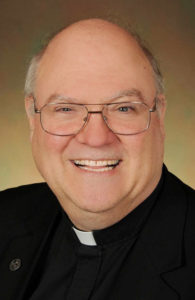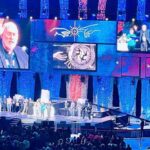By Fr. Jim Betzen
I am a bilingual priest in Ottumwa in that I am fluent in Spanish. How I got to be fluent is the subject of this article. Like many students, I had two years of Spanish in high school and one year in college. I learned Spanish grammar and some vocabulary but in no way was fluent; that would come later. As a seminarian in formation with the Missionaries of the Precious Blood, I had one year of special formation between college and graduate theology.

I spent seven months at St. Mary Church in Garden City, Kan., between September and Easter. When I arrived at St. Mary Church, I was asked if I had learned Spanish in school. Soon I was commissioned a eucharistic minister and gave weekly Communion to Spanish-speaking persons unable to leave their homes. This was a good way to practice speaking Spanish since they wanted to talk; I mostly listened.
Then, the Cursillistas came to the rectory and asked if one of us would be their chaplain. I think that the Holy Spirit inspired me to volunteer. As chaplain, I heard them sing and pray and felt right at home. This experience gave me the motivation to become fluent in Spanish and helped me to understand that in my priesthood I would be working with Spanish-speaking parishioners. This experience also influenced my decision to attend Catholic Theological Union in Chicago where I could continue formation in Spanish-speaking communities. During my studies in Chicago, I did ministry in Spanish-speaking parishes on the near west side.
Ordained in 1981, my first assignment was at a German-Russian parish in North Dakota. I was filling in and waited to go south where I would begin Hispanic ministry. In July of 1983, I went to San Angelo, Texas, and in late August I went to Spanish language school in Mexico City. A fellow priest went with me and we looked for a church near the school. I found a home at Sacred Heart of Jesus Church, seven blocks from the school.
I attended Mexican-North American Cultural Center which taught three-week terms from 9 a.m. to 1 p.m. Being part of Sacred Heart Church, I had daily Mass in Spanish, three Sunday Masses in Spanish and Saturday evening Mass in English for the tourists. The first month, the pastor walked in and gave the homily. After a month, I wrote my homilies and read them. I became fluent by speaking to the pastor, the secretary, the family who lived on the first floor of the rectory and provided services for the rectory and church.
Ministerial and social visits to the parishioners also helped me to become fluent in Spanish. I did sick calls to homes as well as blessings of all sorts. In March of 1983, I returned to Texas to begin Mexican-American ministry. It was very much a bilingual ministry. Generally speaking, the elderly spoke Spanish, the middle-aged were bilingual and the youths spoke English.
In July of 1993, I went to Kansas City, Mo., where I worked as a pastor to a combined parish of Mexican-Americans and immigrants from Central America. I became much more fluent in Spanish since the immigrants spoke only Spanish. Giving baptism classes, doing marriage preparation, and visiting immigrant families improved my fluency in Spanish. In 2004, I went to Sedalia, Mo., where I ministered to Anglos as well as Central American immigrants. Many of the immigrants worked at Tyson Foods, a chicken-processing plant. In 2014, I came to Ottumwa where I continue to work with immigrants from Central America.
It takes motivation to learn a foreign language. My motivation came from wanting to communicate my faith in Spanish and the enjoyment of being with Hispanic immigrants. It also takes humility to learn a foreign language because I think that one needs to be more like a child. One needs to begin with simple, short statements and to listen well. Children learn from listening to adults speak.
One also has to be patient. As you listen to and speak Spanish for a considerable time, you will begin to think in Spanish rather than English; that is a great accomplishment. One way to learn Spanish besides taking adult classes is to watch Spanish TV. Watching the news in Spanish is a good method since most news is repetitious and familiar. If you have access to a bilingual missalette, you could read the Spanish readings right after you read the English. To become fluent in Spanish, one needs to visit neighbors who speak Spanish, which shouldn’t be difficult to find in many of our Iowa towns.
(Fr. Jim Betzen is pastor of St. Mary of the Visitation Parish in Ottumwa.)











